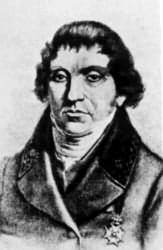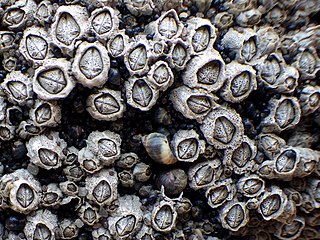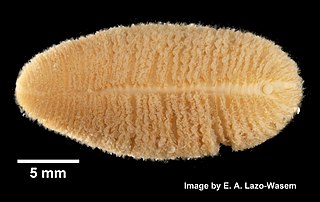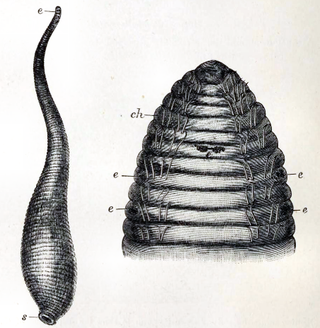
Nereis is a genus of polychaete worms in the family Nereididae. It comprises many species, most of which are marine. Nereis possess setae and parapodia for locomotion and gas exchange. They may have two types of setae, which are found on the parapodia. Acicular setae provide support. Locomotor setae are for crawling, and are the bristles that are visible on the exterior of the Polychaeta. They are cylindrical in shape, found not only in sandy areas, and they are adapted to burrow. They often cling to seagrass (posidonia) or other grass on rocks and sometimes gather in large groups.

Planaria is a genus of planarians in the family Planariidae. When an individual is cut into pieces, each piece has the ability to regenerate into a fully formed individual.

Georg (Göran) Wahlenberg was a Swedish naturalist. He was born in Kroppa, Värmland County.

Pectinaria is a genus of sand tube-building annelid fanworms in the family Pectinariidae.

The Arthoniales is the second largest order of mainly crustose lichens, but fruticose lichens are present as well. The order contains around 1500 species, while the largest order with lichenized fungi, the Lecanorales, contains more than 14000 species.

The Arthoniaceae are a family of lichenized, lichenicolous and saprobic fungi in the order Arthoniales. The Arthoniaceae is the largest family of Arthoniales, with around 800 species. Most species in Arthoniaceae belong in Arthonia which is the largest genus with 500 species. The second and third largest genus is Arthothelium with 80 species, and Cryptothecia with 60 species.

Xanthopyreniaceae is a family of lichen-forming fungi in the order Collemopsidiales. The family was circumscribed by lichenologist Alexander Zahlbruckner in 1926.
Frigidopyrenia is a fungal genus in the family Xanthopyreniaceae. It is a monotypic genus, containing the single species Frigidopyrenia bryospila, a subarctic crustose lichen. This lichen was originally described by Finnish lichenologist William Nylander in 1864 as Verrucaria bryospila. It was shuffled to several genera in its taxonomic history before Martin Grube circumscribed Frigidopyrenia in 2005 to contain it. As of 2017, no molecular sequence data was available for Frigidopyrenia.
Zwackhiomyces is a genus of lichenicolous fungi in the family Xanthopyreniaceae. The genus was circumscribed by Martin Grube and Josef Hafellner in 1990, with Zwackhiomyces coepulonus assigned as the type species.

Vermetus is a genus of sea snails, marine gastropod mollusks in the family Vermetidae, the worm snails or worm shells.

Spintheridae is a family of marine polychaete worms with a single genus, Spinther, containing these species:
Parasiphula is a genus of crustose lichens in the family Coccotremataceae. The genus was circumscribed by Gintaras Kantvilas and Martin Grube in 2006, and contains seven species that are known from cool to cold latitudes in the Southern Hemisphere.

Thysanozoon is a genus of polyclad flatworms belonging to the family Pseudocerotidae.
Strigiphilus is a genus of chewing louse in the suborder Ischnocera. It was circumscribed in 1910 by Eric Mjöberg.

Bispira is a genus of marine bristleworm in the family Sabellidae. Its members were initially included in genus Sabella by Grube in 1851. In 1856, Krøyer described Bispira as a separate genus. Members of Bispira are defined by spirally-coiled, equally-divided branchial lobes.

Acanthobdella peledina is a species of leech-like clitellate in the order Acanthobdellida. It feeds on the skin and blood of freshwater fishes in the boreal regions of northern Europe, Asia and North America.

Acanthobdellidea is an infraclass of primitive leeches; some authors place them in a separate subclass from the Hirudinea. However, the World Register of Marine Species places them within the Hirudinea, as a sister group to Euhirudinea, the true leeches.
Platybrissus is a genus of echinoderms belonging to the family Eurypatagidae.
Cirratulus is a genus of annelids belonging to the family Cirratulidae.












